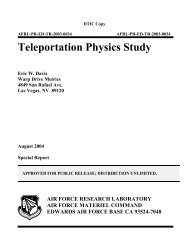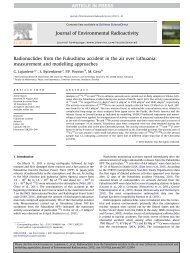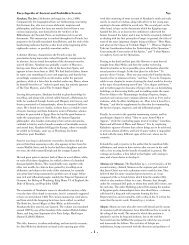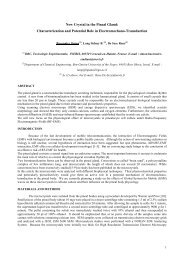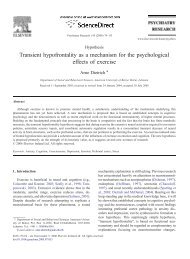him to disengage from the organization.- As far as I can tell, however, there is no formal “oathing” ceremony involved in becoming amember.- Young men approached to become etarras typically resist joining for a very long time before theycast their lot with the organization. Virtually every case study reports that the young man resistedthe first invitations to join, sometimes for as long as 18 months or two years, before finally decidingto become a member. The reasons for delay vary from case to case. Great majority <strong>of</strong> the members<strong>of</strong> ETA continue to live at home. Being a member <strong>of</strong> ETA is time consuming, to be sure; and manymembers report having little time left over for the demands <strong>of</strong> their personal lives once they join.- There are, in general, three kinds <strong>of</strong> activities that occupy the time and energy <strong>of</strong> members <strong>of</strong> ETA.The first involves what we might call consciousness raising. The second general type <strong>of</strong> activityengaged in by ETA members has to do with support services for the armed comandos <strong>of</strong> theorganization. The third kind <strong>of</strong> activity undertaken by ETA members is, <strong>of</strong> course, armed assaults onpersons or property, with the intention either to kill or injure people, to kidnap them for subsequentransoms, or to seize money, weapons, automobiles, or other needed resources. My feeling is thatfewer than half <strong>of</strong> the ETA members actually engage in violent actions <strong>of</strong> this sort. But they are theones that give the organization its special insurgent character, as well as attract all the attention.- ETA comandos were given orders to conduct armed attacks about once every eight months- Abouthalf the attacks were conducted in the home town <strong>of</strong> members <strong>of</strong> the assault comando- For activeetarras, however, the principal source <strong>of</strong> support seems to me to be the small circle <strong>of</strong> friends, jobassociates, and other ETA members who cluster together for mutual psychological support andassistance.-Most <strong>of</strong> the etarras about whom I have such personal data fell into one <strong>of</strong> two categories. Many hadno real lasting relationships with women-There were others, however, who solved the problemessentially by courting and marrying women who likewise had committed themselves torevolutionary struggle.-That these were not especially happy men but they continued the struggle out <strong>of</strong> a combination <strong>of</strong>factors that blends both positive and negative reinforcements. On the positive side, they receivedsolid support from their close friends and from their spouses (if they were married).-They had also learned to lower their expectation. There are, however, negative forces at work thatdiscourage etarras from leaving the organization, no matter how depressed they may become.-There is, simply put, a fear <strong>of</strong> reprisals- the simple fact <strong>of</strong> the matter is that men usually spendrather brief periods <strong>of</strong> time as ETA members.- I would estimate that the average length <strong>of</strong> time that an etarras spends as an active member <strong>of</strong> theorganization would be less than three years.- Obviously, a number <strong>of</strong> them are killed. Many,probably the majority, are caught and sentenced to long prison terms. And <strong>of</strong> course, there are thosecountless etarras in insignificant support roles who simply blend back into the environment afterthey “retire” from the organization. For some young Basques, ETA is a crucial end point in theirlives, the determinative factor that gives meaning and purpose to an otherwise disorderly and ratherpointless frustration.40. Clayton C. J., Barlow S. H., & Baliff-Spanville B. (1998). Principles <strong>of</strong> group violence with a focus onterrorism . H. V. Hall, & L. C. Witaker (Ed), Collective violence: Effective strategies for assessingand interviewing in fatal group and institutional aggression (pp. 277-312). CRC Press.Call Number: Editor's Annotation: In this chapter, the authors present a compendium <strong>of</strong>psychological principles that contribute to understanding group violence, followed by a discussion <strong>of</strong>terrorism as an example <strong>of</strong> group violence. The authors then propose a general model <strong>of</strong> motivationfor participating in group violence and summarize the processes that contribute to the development<strong>of</strong> such motivation.-The Contribution <strong>of</strong> Group: Processes to Violence- Long ago, Gustave Lebon (1896) argued thatcrowds <strong>of</strong> people may act as entities unto themselves, as if the whole were controlled by oneirrational mind with primitive motivations, with members <strong>of</strong> the crowd losing their individual sense<strong>of</strong> responsibility. Festinger, Pepitone, and Newcomb (as reported in Forsyth, 1994, p. 442) coinedthe term “deindividuation” to describe how individuals become “so submerged in the group that theyno longer stand out as individuals.” Zimbardo (1969) continued the research and developed aprocess model that noted that lowered threshold <strong>of</strong> normally restrained behavior is brought about by
a sense <strong>of</strong> anonymity and diffusion <strong>of</strong> responsibility.- The critical ways in which deindividuation leads to violence appear to include feelings <strong>of</strong>anonymity and reduced responsibility, as well as internal changes that include reduced selfawarenessand perceptual disturbances.- The other concept that should be included in this discussion is the process <strong>of</strong> groupthink (Janis,1982, p. 552)- “a mode <strong>of</strong> thinking that people engage in when they are deeply involved in acohesive in-group, when the members’ striving for unanimity overrides their motivation torealistically appraise alternative courses <strong>of</strong> action.” Groupthink reinforces and is in turn reinforcedby the shared beliefs <strong>of</strong> the group members. - Stronger group identity appears to be associated withincreased violence. In an archival study, Mullen (1986) analyzed newspaper accounts <strong>of</strong> lynch mobsin the U.S. in the late 1800s to early 1900s. He noted that as lynchers became more numerousrelative to the victims, the lynchers became less “ self-attentive” and more deindividuated.- Bandura (1986, 1990) posited three categories <strong>of</strong> psychosocial mechanisms that can operate todistance people from morally based self-control: (1) moral justification; (2) minimizing, ignoring, ormisconstruing consequences; and (3) dehumanizing the objects <strong>of</strong> aggression.- Ryan (1997) suggested that the concept <strong>of</strong> “chosenness”, particularly in the Judeo-Christiantradition has been a driving force in the self-righteous justification <strong>of</strong> destroying or subjugatinggroups seen as “not chosen”.- Diffusion <strong>of</strong> responsibility occurs when people in a group feel less responsible for acting or makingdecisions than they would if they were alone (Schwartz and Gottlieb, 1980)- Dehumanization <strong>of</strong> theopponent enhances people’s willingness to use violence.- Bandura (1990) made the point that empathic responses to others’ experiences depend in large parton whether or not we view them as similar to ourselves and that empathic responses strengthen selfsanctionsagainst harming the object for our empathy.- The influence <strong>of</strong> the social environment generally is more powerful than that <strong>of</strong> individualcharacteristics in promoting a dehumanizing attitude. Authoritarian institutional influences areparticularly powerful.- Long (1990) suggested it might be more useful to try to identify “ the most common characteristics<strong>of</strong> terrorism, regardless <strong>of</strong> whether any particular one or combination <strong>of</strong> them is present in any givencase” (p.4). He listed four categories: goals, strategies, operations, and organization.- The most prominent explanations <strong>of</strong> terrorism fall into three categories: structural, rational choice,and psychological (Ross, 1993). Structural theories utilize the view that terrorism is caused byenvironmental, political, cultural, economic, and social factors in societies; rational choice theoriesexplain terrorism in terms <strong>of</strong> cost/benefit analysis by the participants; and psychological theoriesaddress individual and group dynamics in relationship to the formation <strong>of</strong> terrorist groups and thecommission <strong>of</strong> terrorist acts.- Ross (1993) constructed a causal model based on structure. He posited three “permissive” causes:geographical location, type <strong>of</strong> political system, and level <strong>of</strong> modernization, and seven “precipitant”causes (listed in order from least to most important): social, cultural, and historical facilitation:organizational split and development: presence <strong>of</strong> other forms <strong>of</strong> unrest: support: counterterroristorganization failure: availability <strong>of</strong> weapons and explosives: and grievances. The permissive causesact as facilitators <strong>of</strong> the precipitant causes.- Ross (1993, p.323) agreed with Laquer (1977, p.103) that “most terrorist groups come intoexistence as the ‘result <strong>of</strong> a split between the moderate and the more extreme wings <strong>of</strong> an alreadyexistingorganization’ (e.g., political party).” Ross postulated that the more splitting that occurswithin terrorist organizations, the greater the likelihood that at least one <strong>of</strong> the splinter groups willadvocate or use terrorism.- Ross hypothesized that the greater the amount <strong>of</strong> support, the greater the failure <strong>of</strong> counterterroristefforts, and, conversely, the greater the failure <strong>of</strong> counterterrorist efforts, the greater the amount <strong>of</strong>support for terrorists. Ross suggested that the greater the availability <strong>of</strong> weapons and explosives, thegreater the incidence <strong>of</strong> terrorism.- The last and most important precipitant cause is grievances. Ross (1993, p.326) parceled them intoseven categories: economic, ethnic, racial, legal, political, religious, and social. These grievancescan be directed against “individuals, groups, organizations, classes, races, and ethnicities, bothpublic and private.” Left unaddressed, serious grievances can result in the formation <strong>of</strong> socialmovements or interests groups that can, under the influence <strong>of</strong> the factors mentioned above, evolve
- Page 2 and 3: MethodologyWe have defined terroris
- Page 4 and 5: Reference List1. Root causes of ter
- Page 6 and 7: - The experience of discrimination
- Page 8 and 9: justification across all three reli
- Page 10 and 11: 11. Bandura, A. (2003). The origins
- Page 12 and 13: ather then from their own volition.
- Page 14 and 15: -If the women's liberation movement
- Page 16 and 17: technology and science.-Although mo
- Page 18 and 19: effects that help facilitate violen
- Page 20 and 21: academic fields of study.-Terrorism
- Page 22 and 23: one’s own group and towards other
- Page 24 and 25: marked cars, do not mount stationar
- Page 26 and 27: ethnic group: he or she must also s
- Page 28 and 29: third option involves becoming 'thr
- Page 30 and 31: discriminative stimuli that are tem
- Page 34 and 35: or split into terrorist organizatio
- Page 36 and 37: -Part of the complexity of terroris
- Page 38 and 39: focuses on the depressive character
- Page 40 and 41: Call Number: Editor's Annotation: W
- Page 42 and 43: unanimity has only infrequently ser
- Page 44 and 45: sensitivity to betrayal, and securi
- Page 46 and 47: -People may not support a resistanc
- Page 48 and 49: splinter off from the main organiza
- Page 50 and 51: seduced by the lures of omnipotence
- Page 52 and 53: Most past research findings are bas
- Page 54 and 55: terrorist groups break away from la
- Page 56 and 57: -A second general theory of organiz
- Page 58 and 59: -Violence was justified, first of a
- Page 60 and 61: -Conclusion: When disruptive social
- Page 62 and 63: Call Number: Editor's Annotation: C
- Page 64 and 65: terrorist groups even between group
- Page 66 and 67: grievances and his concomitant will
- Page 68 and 69: -Yet forecasting requires theory, t
- Page 70 and 71: highly organized or institutionaliz
- Page 72 and 73: -Underprivileged groups are likely
- Page 74 and 75: situations where the terrorist moti
- Page 76 and 77: 1977), including in the Palestinian
- Page 78 and 79: -Nor can a general theory of civil
- Page 80 and 81: extent to which deprived occupy org
- Page 82 and 83:
-The necessary dependence on new-se
- Page 84 and 85:
it relates specifically to the regi
- Page 86 and 87:
or class of phenomena, within a giv
- Page 88 and 89:
progress in the analysis of terrori
- Page 90 and 91:
-Loyalty in the face of continuing
- Page 92 and 93:
Republican electorate and also with
- Page 94 and 95:
ecent 1994-96 cease-fire.- certain
- Page 96 and 97:
e reported in news media. Even if a
- Page 98:
eaccompanied back to Italy where he
- Page 101 and 102:
(non believers) facilitates violenc
- Page 103 and 104:
disagreements and disharmony. There
- Page 105 and 106:
autonomy, colonial liberation, raci
- Page 107 and 108:
introduced as the seminal, grass ro
- Page 109 and 110:
identity over personal and familiar
- Page 111 and 112:
-Finally, a comprehensive policy to
- Page 113 and 114:
-It would be naive to think of suic
- Page 115 and 116:
negotiator for the specific situati
- Page 117 and 118:
efused to fight in the Lebanese war
- Page 119 and 120:
-It has been our impression from fr
- Page 121 and 122:
-Many efforts have been made to cat
- Page 123 and 124:
drives that are brought about by (a
- Page 125 and 126:
word.-Consider now the value of ter
- Page 127 and 128:
-The interaction of deprivation and
- Page 129 and 130:
maximize its expected political ret
- Page 131 and 132:
insights into the underlying dynami
- Page 133 and 134:
lengths to secure materials and tec
- Page 135 and 136:
influencing the success of amnesty
- Page 137 and 138:
-The great diversity of terrorism a
- Page 139 and 140:
205. Monroe, K. R., & Kreidie, L. H
- Page 141 and 142:
Call Number: Published Abstract: Di
- Page 143 and 144:
physiological and psychiatric appro
- Page 145 and 146:
2001, suicide attacks amount to 3%
- Page 147 and 148:
numbersas an offering to the bloodt
- Page 149 and 150:
etween radical family involvement a
- Page 151 and 152:
there is no ambivalence concerning
- Page 153 and 154:
dynamics the ‘anarchic-ideologues
- Page 155 and 156:
especially with the parents (33 per
- Page 157 and 158:
esult.-The world is divided into tw
- Page 159 and 160:
pressure from supporters, internal
- Page 161 and 162:
- 1.00 Historical, Cultural, and Co
- Page 163 and 164:
personal rivalry- An extremist fact
- Page 165 and 166:
national governments. At this preli
- Page 167 and 168:
-Normative Orientations directs peo
- Page 169 and 170:
Sicarii views. Insurrection was onl
- Page 171 and 172:
-To have a space of one’s own is
- Page 173 and 174:
outside the normal range of violenc
- Page 175 and 176:
-Various governments sought to curb
- Page 177 and 178:
e older (i.e., 40's-50's)-Sex: Pred
- Page 179 and 180:
liberation Tigers of Tamil Ealam (L
- Page 181 and 182:
electronic communication and inform
- Page 183 and 184:
any other topic on which so much ha
- Page 185 and 186:
has exposed some particular cause b
- Page 187 and 188:
and alone. Ultimately, terrorism re
- Page 189 and 190:
-Conclusions: The motives for param
- Page 191 and 192:
272. Sprinzak, E. (2001). Rational
- Page 193 and 194:
-One way for individuals to handle
- Page 195 and 196:
-Theories of Hate: Fromm (1973/1992
- Page 197 and 198:
student tells the convict his misde
- Page 199 and 200:
literate in EnglishPoor verbal skil
- Page 201 and 202:
features: focusing; personalized vi
- Page 203 and 204:
-Even if idiosyncratic, the process
- Page 205 and 206:
some other agencies’ inaction. We
- Page 207 and 208:
-The RWA is probably the instrument
- Page 209 and 210:
students choose Communist student o
- Page 211 and 212:
state-oriented tradition: by taking
- Page 213 and 214:
phase of semi legality.-Helpers and
- Page 215 and 216:
the neo-Fascists were over 40 years
- Page 217 and 218:
commonality can be found in the utt
- Page 219 and 220:
geographical, and we consider it in
- Page 221:
-The violence struggle against the



